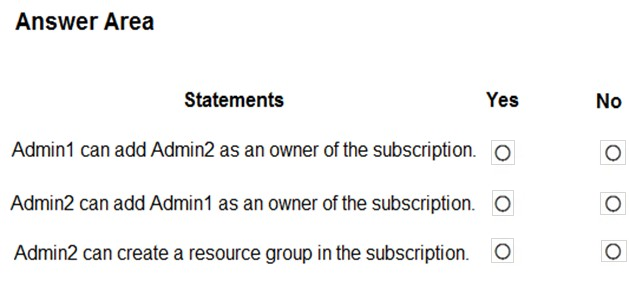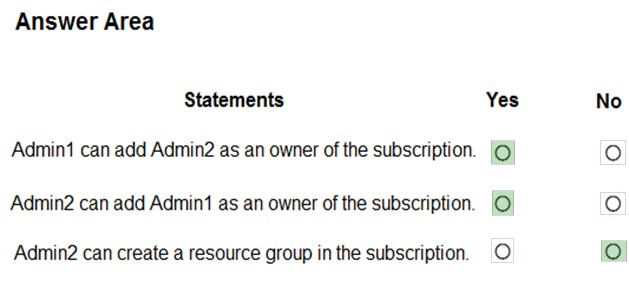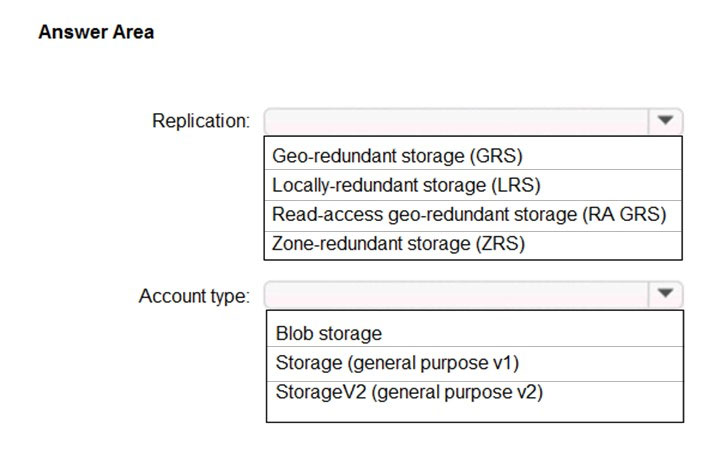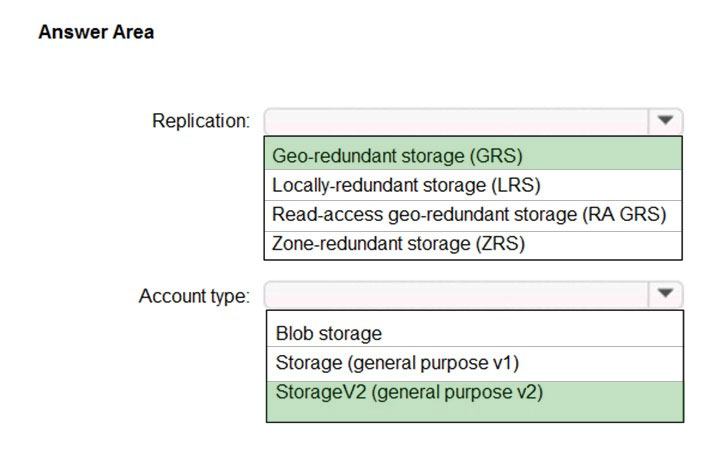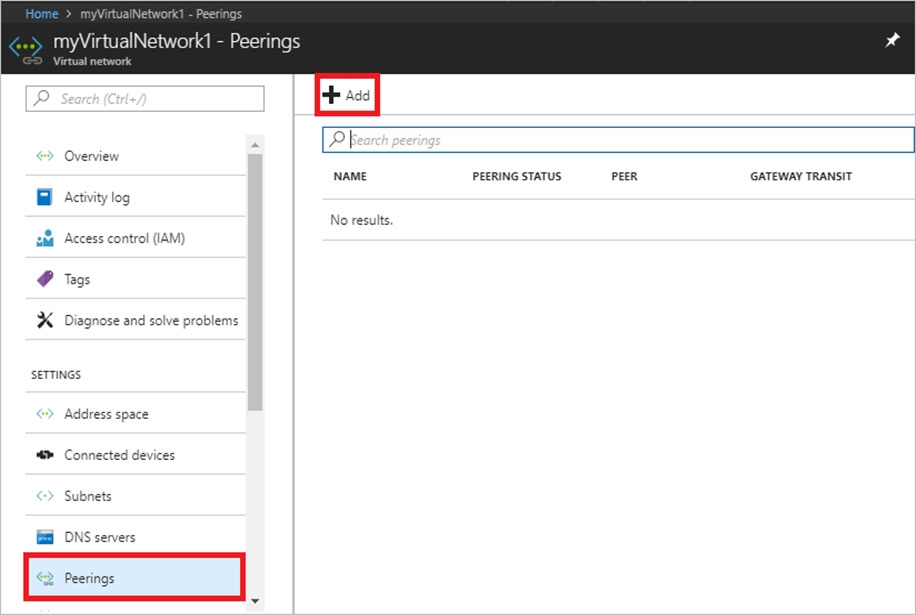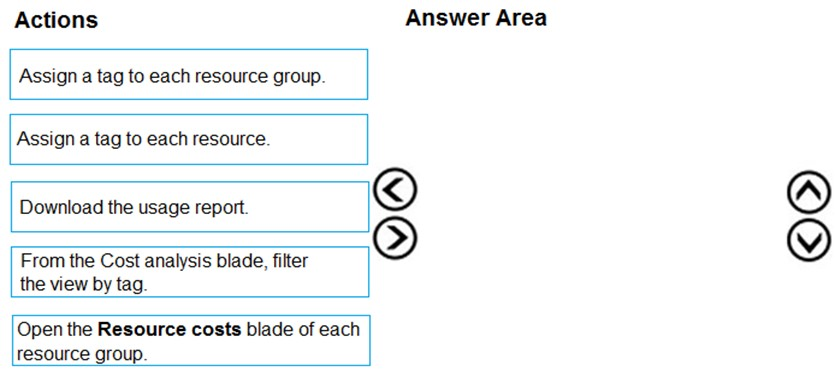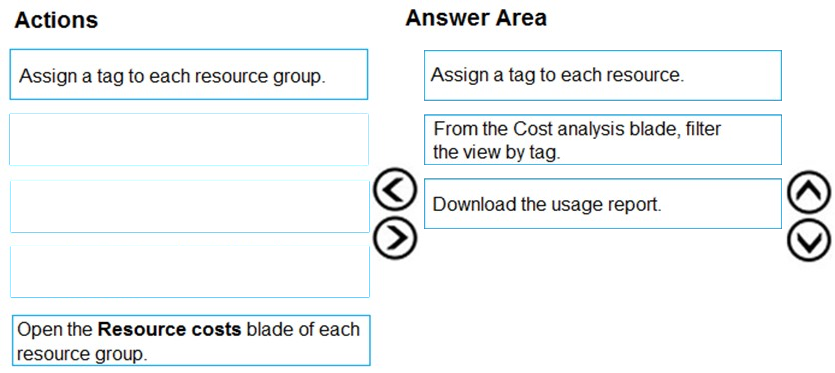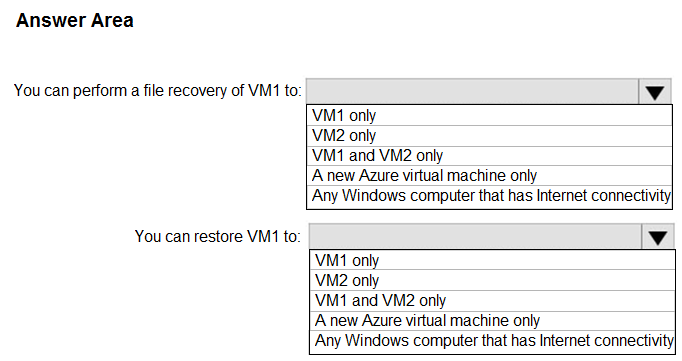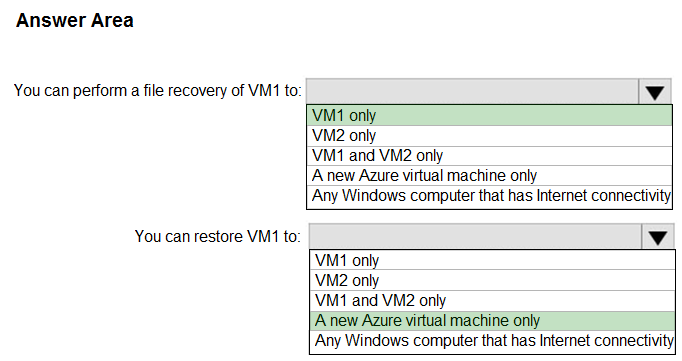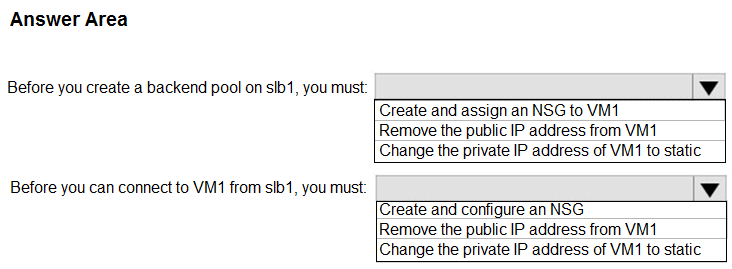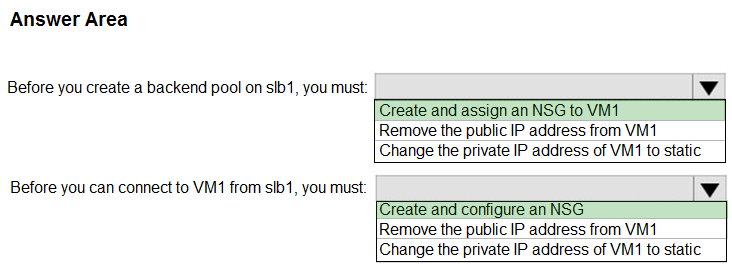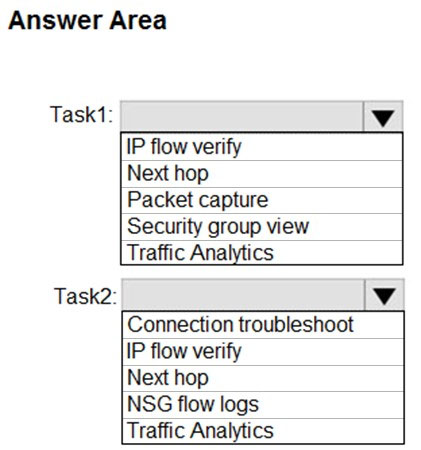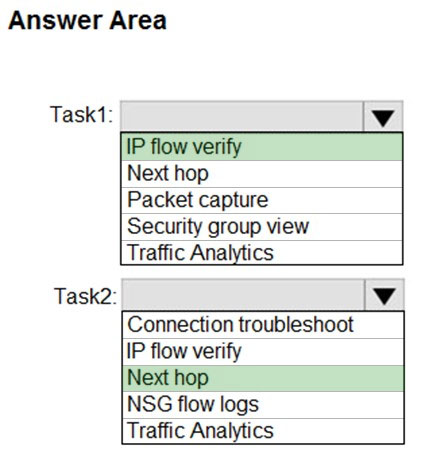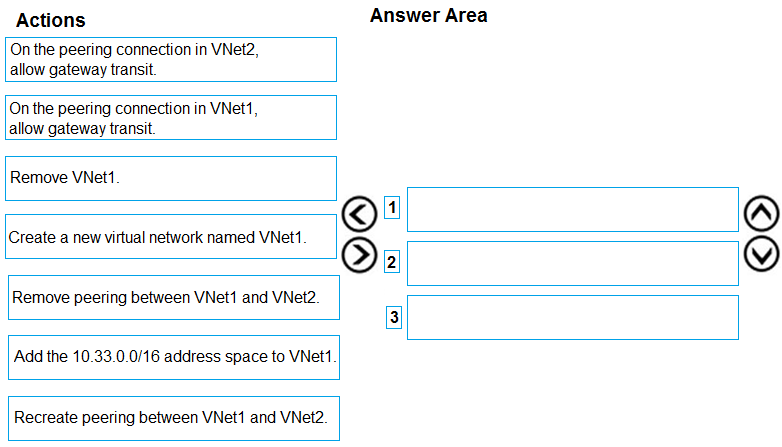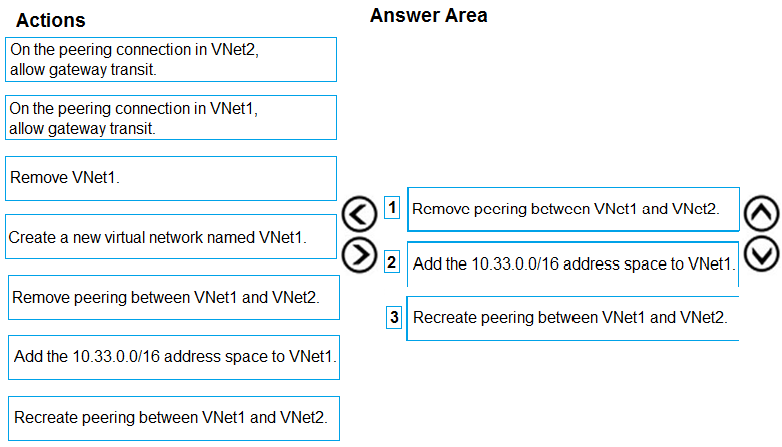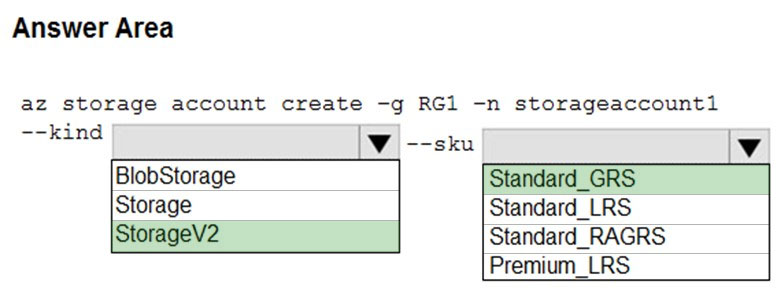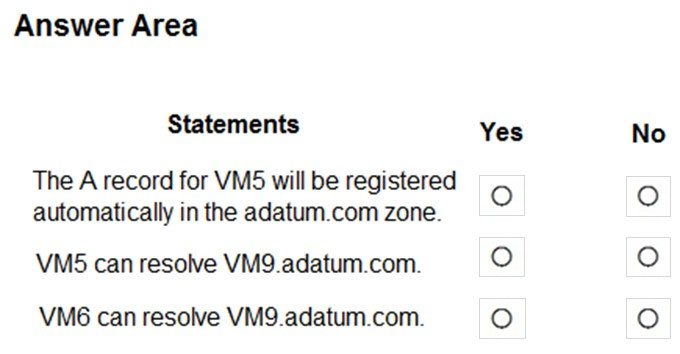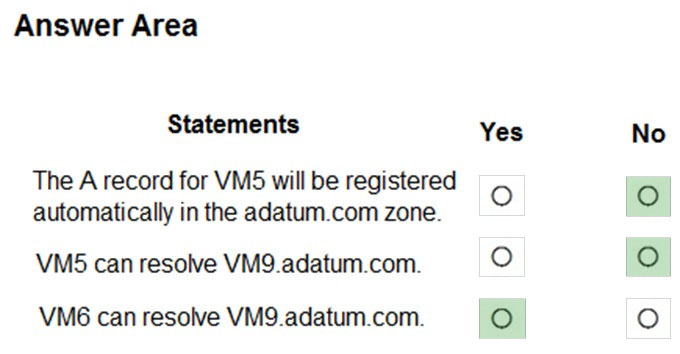AZ-103 Exam Prep Free – 50 Practice Questions to Get You Ready for Exam Day
Getting ready for the AZ-103 certification? Our AZ-103 Exam Prep Free resource includes 50 exam-style questions designed to help you practice effectively and feel confident on test day
Effective AZ-103 exam prep free is the key to success. With our free practice questions, you can:
- Get familiar with exam format and question style
- Identify which topics you’ve mastered—and which need more review
- Boost your confidence and reduce exam anxiety
Below, you will find 50 realistic AZ-103 Exam Prep Free questions that cover key exam topics. These questions are designed to reflect the structure and challenge level of the actual exam, making them perfect for your study routine.
You need to resolve the licensing issue before you attempt to assign the license again. What should you do?
A. From the Groups blade, invite the user accounts to a new group.
B. From the Profile blade, modify the usage location.
C. From the Directory role blade, modify the directory role.
Your company has a main office in London that contains 100 client computers. Three years ago, you migrated to Azure Active Directory (Azure AD). The company's security policy states that all personal devices and corporate-owned devices must be registered or joined to Azure AD. A remote user named User1 is unable to join a personal device to Azure AD from a home network. You verify that other users can join their devices to Azure AD. You need to ensure that User1 can join the device to Azure AD. What should you do?
A. From the Device settings blade, modify the Users may join devices to Azure AD setting.
B. From the Device settings blade, modify the Maximum number of devices per user setting.
C. Create a point-to-site VPN from the home network of User1 to Azure.
D. Assign the User administrator role to User1.
HOTSPOT - You have an Azure subscription named Subscription1 that contains a resource group named RG1. In RG1, you create an internal load balancer named LB1 and a public load balancer named LB2. You need to ensure that an administrator named Admin1 can manage LB1 and LB2. The solution must follow the principle of least privilege. Which role should you assign to Admin1 for each task? To answer, select the appropriate options in the answer area. NOTE: Each correct selection is worth one point. Hot Area:
You have an Azure subscription named Subscription1 that contains an Azure Log Analytics workspace named Workspace1. You need to view the error events from a table named Event. Which query should you run in Workspace1?
A. search in (Event) * | where EventType “”eq “error”
B. search in (Event) “error”
C. select *from Event where EventType is “error”
D. Event | where EventType is “error”
DRAG DROP - You have an Azure Active Directory (Azure AD) tenant that has the initial domain name. You have a domain name of contoso.com registered at a third-party registrar. You need to ensure that you can create Azure AD users that have names containing a suffix of @contoso.com. Which three actions should you perform in sequence? To answer, move the appropriate cmdlets from the list of cmdlets to the answer area and arrange them in the correct order. Select and Place:
After you answer a question in this section, you will NOT be able to return to it. As a result, these questions will not appear in the review screen. You have an Azure Active Directory (Azure AD) tenant named Adatum and an Azure Subscription named Subscription1. Adatum contains a group named Developers. Subscription1 contains a resource group named Dev. You need to provide the Developers group with the ability to create Azure logic apps in the Dev resource group. Solution: On Subscription1, you assign the DevTest Labs User role to the Developers group. Does this meet the goal?
A. Yes
B. No
You have an Azure subscription. You have an on-premises virtual machine named VM1. The settings for VM1 are shown in the exhibit. (Click the Exhibit tab.)You need to ensure that you can use the disks attached to VM1 as a template for Azure virtual machines. What should you modify on VM1?
A. the hard drive
B. the processor
C. the network adapters
D. the memory
E. Integration Services
After you answer a question in this section, you will NOT be able to return to it. As a result, these questions will not appear in the review screen. You have an Azure subscription that contains the following resources: ✑ A virtual network that has a subnet named Subnet1 ✑ Two network security groups (NSGs) named NSG-VM1 and NSG-Subnet1 ✑ A virtual machine named VM1 that has the required Windows Server configurations to allow Remote Desktop connections NSG-Subnet1 has the default inbound security rules only. NSG-VM1 has the default inbound security rules and the following custom inbound security rule: ✑ Priority: 100 ✑ Source: Any ✑ Source port range: * ✑ Destination: * ✑ Destination port range: 3389 ✑ Protocol: UDP ✑ Action: Allow VM1 connects to Subnet1. NSG1-VM1 is associated to the network interface of VM1. NSG-Subnet1 is associated to Subnet1. You need to be able to establish Remote Desktop connections from the internet to VM1. Solution: You add an inbound security rule to NSG-Subnet1 that allows connections from the Any source to the * destination for port range 3389 and uses the TCP protocol. You remove NSG-VM1 from the network interface of VM1. Does this meet the goal?
A. Yes
B. No
HOTSPOT - You have an Azure Active Directory (Azure AD) tenant that contains three global administrators named Admin1, Admin2, and Admin3. The tenant is associated to an Azure subscription. Access control for the subscription is configured as shown in the Access control exhibit. (Click the Exhibit tab.)You sign in to the Azure portal as Admin1 and configure the tenant as shown in the Tenant exhibit. (Click the Exhibit tab.)
For each of the following statements, select Yes if the statement is true. Otherwise, select No. NOTE: Each correct selection is worth one point. Hot Area:
You have a public load balancer that balances ports 80 and 443 across three virtual machines. You need to direct all the Remote Desktop Protocol (RDP) connections to VM3 only. What should you configure?
A. an inbound NAT rule
B. a load balancing rule
C. a new public load balancer for VM3
D. a frontend IP configuration
HOTSPOT - You plan to create an Azure Storage account in the Azure region of East US 2. You need to create a storage account that meets the following requirements: ✑ Replicates synchronously. ✑ Remains available if a single data center in the region fails. How should you configure the storage account? To answer, select the appropriate options in the answer area. NOTE: Each correct selection is worth one point. Hot Area:
You have an Azure subscription named Subscription1. You have 5 TB of data that you need to transfer to Subscription1. You plan to use an Azure Import/Export job. What can you use as the destination of the imported data?
A. an Azure Cosmos DB database
B. Azure File Storage
C. the Azure File Sync Storage Sync Service
D. Azure Data Factory
HOTSPOT - You are evaluating the name resolution for the virtual machines after the planned implementation of the Azure networking infrastructure. For each of the following statements, select Yes if the statement is true. Otherwise, select No. Hot Area:
After you answer a question in this section, you will NOT be able to return to it. As a result, these questions will not appear in the review screen. You have an Azure subscription that contains the following resources: ✑ A virtual network that has a subnet named Subnet1 ✑ Two network security groups (NSGs) named NSG-VM1 and NSG-Subnet1 ✑ A virtual machine named VM1 that has the required Windows Server configurations to allow Remote Desktop connections NSG-Subnet1 has the default inbound security rules only. NSG-VM1 has the default inbound security rules and the following custom inbound security rule: ✑ Priority: 100 ✑ Source: Any ✑ Source port range: * ✑ Destination: * ✑ Destination port range: 3389 ✑ Protocol: UDP ✑ Action: Allow VM1 connects to Subnet1. NSG1-VM1 is associated to the network interface of VM1. NSG-Subnet1 is associated to Subnet1. You need to be able to establish Remote Desktop connections from the internet to VM1. Solution: You add an inbound security rule to NSG-Subnet1 and NSG-VM1 that allows connections from the internet source to the VirtualNetwork destination for port range 3389 and uses the TCP protocol. Does this meet the goal?
A. Yes
B. No
SIMULATION - Please wait while the virtual machine loads. Once loaded, you may proceed to the lab section. This may take a few minutes, and the wait time will not be deducted from your overall test time. When the Next button is available, click it to access the lab section. In this section, you will perform a set of tasks in a live environment. While most functionality will be available to you as it would be in a live environment, some functionality (e.g, copy and paste, ability to navigate to external websites) will not be possible by design. Scoring is based on the outcome of performing the tasks stated in the lab. In other words, it doesn't matter how you accomplish the task, if you successfully perform it, you will earn credit for that task. Labs are not timed separately, and this exam may have more than one lab that you must complete. You can use as much time as you would like to complete each lab. But, you should manage your time appropriately to ensure that you are able to complete the lab(s) and all other sections of the exam in the time provided. Please note that once you submit your work by clicking the Next button within a lab, you will NOT be able to return to the lab. You may now click next to proceed to the lab. Use the following login credentials as needed: Azure Username: XXXXXXX - Azure Password: XXXXXXX - The following information is for technical support purposes only: Lab Instance: 9172796 -You plan to allow connections between the VNET01-USEA2 and VNET01-USWE2 virtual networks. You need to ensure that virtual machines can communicate across both virtual networks by using their private IP address. The solution must NOT require any virtual network gateways. What should you do from the Azure portal?
DRAG DROP - You have an Azure subscription that is used by four departments in your company. The subscription contains 10 resource groups. Each department uses resources in several resource groups. You need to send a report to the finance department. The report must detail the costs for each department. Which three actions should you perform in sequence? To answer, move the appropriate actions from the list of actions to the answer area and arrange them in the correct order. Select and Place:
You have an Azure Active Directory (Azure AD) tenant named contoso.onmicrosoft.com. You hire a temporary vendor. The vendor uses a Microsoft account that has a sign-in of user1@outlook.com . You need to ensure that the vendor can authenticate to the tenant by using user1@outlook.com . What should you do?
A. From the Azure portal, add a custom domain name, create a new Azure AD user, and then specify user1@outlook.com as the username.
B. From Azure Cloud Shell, run the New-AzureADUser cmdlet and specify the “”UserPrincipalName user1@outlook.com parameter.
C. From the Azure portal, add a new guest user, and then specify user1@outlook.com as the email address.
D. From Windows PowerShell, run the New-AzureADUser cmdlet and specify the “”UserPrincipalName user1@outlook.com parameter.
DRAG DROP - You have an on-premises network that you plan to connect to Azure by using a site-to-site VPN. In Azure, you have an Azure virtual network named VNet1 that uses an address space of 10.0.0.0/16. VNet1 contains a subnet named Subnet1 that uses an address space of 10.0.0.0/24. You need to create a site-to-site VPN to Azure. Which four actions should you perform in sequence? To answer, move the appropriate actions from the list of actions to the answer area and arrange them in the correct order. NOTE: More than one order of answer choices is correct. You will receive credit for any of the correct orders you select. Select and Place:
After you answer a question in this section, you will NOT be able to return to it. As a result, these questions will not appear in the review screen. You manage a virtual network named VNet1 that is hosted in the West US Azure region. VNet1 hosts two virtual machines named VM1 and VM2 that run Windows Server. You need to inspect all the network traffic from VM1 to VM2 for a period of three hours. Solution: From Performance Monitor, you create a Data Collector Set (DCS). Does this meet the goal?
A. Yes
B. No
You sign up for Azure Active Directory (Azure AD) Premium. You need to add a user named admin1@contoso.com as an administrator on all the computers that will be joined to the Azure AD domain. What should you configure in Azure AD?
A. Providers from the MFA Server blade
B. Device settings from the Devices blade
C. General settings from the Groups blade
D. User settings from the Users blade
SIMULATION - Please wait while the virtual machine loads. Once loaded, you may proceed to the lab section. This may take a few minutes, and the wait time will not be deducted from your overall test time. When the Next button is available, click it to access the lab section. In this section, you will perform a set of tasks in a live environment. While most functionality will be available to you as it would be in a live environment, some functionality (e.g, copy and paste, ability to navigate to external websites) will not be possible by design. Scoring is based on the outcome of performing the tasks stated in the lab. In other words, it doesn't matter how you accomplish the task, if you successfully perform it, you will earn credit for that task. Labs are not timed separately, and this exam may have more than one lab that you must complete. You can use as much time as you would like to complete each lab. But, you should manage your time appropriately to ensure that you are able to complete the lab(s) and all other sections of the exam in the time provided. Please note that once you submit your work by clicking the Next button within a lab, you will NOT be able to return to the lab. You may now click next to proceed to the lab. Use the following login credentials as needed: Azure Username: XXXXXXX - Azure Password: XXXXXXX - The following information is for technical support purposes only: Lab Instance: 9172796 -Your on-premises network uses an IP address range of 131.107.2.0 to 131.107.2.255. You need to ensure that only device from the on-premises network can connect to the rg1lod9172796n1 storage account. What should you do from the Azure portal?
You have an Azure subscription that contains a resource group named RG1. RG1 contains 100 virtual machines. Your company has three cost centers named Manufacturing, Sales, and Finance. You need to associate each virtual machine to a specific cost center. What should you do?
A. Configure locks for the virtual machine.
B. Add an extension to the virtual machines.
C. Assign tags to the virtual machines.
D. Modify the inventory settings of the virtual machine.
HOTSPOT - You are creating an Azure load balancer. You need to add an IPv6 load balancing rule to the load balancer. How should you complete the Azure PowerShell script? To answer, select the appropriate options in the answer area. NOTE: Each correct selection is worth one point. Hot Area:
You configure Azure AD Connect for Azure Active Directory Seamless Single Sign-On (Azure AD Seamless SSO) for an on-premises network. Users report that when they attempt to access myapps.microsoft.com, they are prompted multiple times to sign in and are forced to use an account name that ends with onmicrosoft.com. You discover that there is a UPN mismatch between Azure AD and the on-premises Active Directory. You need to ensure that the users can use single-sign-on (SSO) to access Azure resources. What should you do first?
A. From the server that runs Azure AD Connect, modify the filtering options.
B. From the on-premises network, deploy Active Directory Federation Services (AD FS).
C. From Azure AD, add and verify a custom domain name.
D. From the on-premises network, request a new certificate that contains the Active Directory domain name.
You have an Azure Active Directory (Azure AD) tenant named contosocloud.onmicrosoft.com. Your company has a public DNS zone for contoso.com. You add contoso.com as a custom domain name to Azure AD. You need to ensure that Azure can verify the domain name. Which type of DNS record should you create?
A. SRV
B. PTR
C. RRSIG
D. TXT
HOTSPOT - You have an Azure subscription named Subscription1. Subscription1 contains two Azure virtual machines named VM1 and VM2. VM1 and VM2 run Windows Server 2016. VM1 is backed up daily by Azure Backup without using the Azure Backup agent. VM1 is affected by ransomware that encrypts data. You need to restore the latest backup of VM1. To which location can you restore the backup? To answer, select the appropriate options in the answer area. NOTE: Each correct selection is worth one point. Hot Area:
SIMULATION - Please wait while the virtual machine loads. Once loaded, you may proceed to the lab section. This may take a few minutes, and the wait time will not be deducted from your overall test time. When the Next button is available, click it to access the lab section. In this section, you will perform a set of tasks in a live environment. While most functionality will be available to you as it would be in a live environment, some functionality (e.g, copy and paste, ability to navigate to external websites) will not be possible by design. Scoring is based on the outcome of performing the tasks stated in the lab. In other words, it doesn't matter how you accomplish the task, if you successfully perform it, you will earn credit for that task. Labs are not timed separately, and this exam may have more than one lab that you must complete. You can use as much time as you would like to complete each lab. But, you should manage your time appropriately to ensure that you are able to complete the lab(s) and all other sections of the exam in the time provided. Please note that once you submit your work by clicking the Next button within a lab, you will NOT be able to return to the lab. You may now click next to proceed to the lab.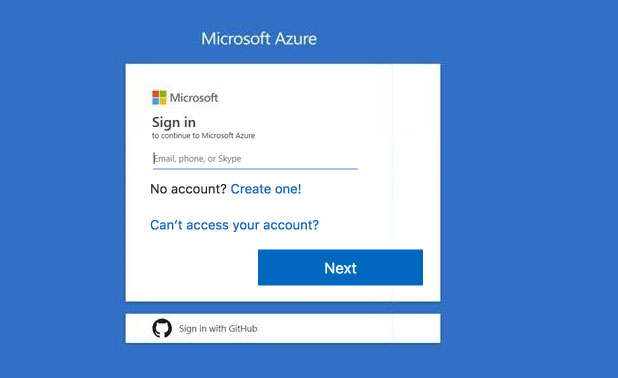
You need to create a virtual network named VNET1008 that contains three subnets named subnet0, subnet1, and subnet2. The solution must meet the following requirements: ✑ Connections from any of the subnets to the Internet must be blocked. ✑ Connections from the Internet to any of the subnets must be blocked. ✑ The number of network security groups (NSGs) and NSG rules must be minimized. What should you do from the Azure portal?
You have an Azure subscription that contains 100 virtual machines. You regularly create and delete virtual machines. You need to identify unattached disks that can be deleted. What should you do?
A. From Microsoft Azure Storage Explorer, view the Account Management properties.
B. From the Azure portal, configure the Advisor recommendations.
C. From Azure Cost Management, view Advisor Recommendations.
D. From Azure Cost Management, view Cost Analysis.
After you answer a question in this section, you will NOT be able to return to it. As a result, these questions will not appear in the review screen. You manage a virtual network named VNet1 that is hosted in the West US Azure region. VNet1 hosts two virtual machines named VM1 and VM2 that run Windows Server. You need to inspect all the network traffic from VM1 to VM2 for a period of three hours. Solution: From Azure Network Watcher, you create a connection monitor. Does this meet the goal?
A. Yes
B. No
You have an Azure subscription that contains the following resources: ✑ 100 Azure virtual machines ✑ 20 Azure SQL databases ✑ 50 Azure file shares You need to create a daily backup of all the resources by using Azure Backup. What is the minimum number of backup policies that you must create?
A. 1
B. 2
C. 3
D. 150
E. 170
You have five Azure virtual machines that run Windows Server 2016. The virtual machines are configured as web servers. You have an Azure load balancer named LB1 that provides load balancing services for the virtual machines. You need to ensure that visitors are serviced by the same web server for each request. What should you configure?
A. Idle Time-out (minutes) to 20
B. Floating IP (direct server return) to Disabled
C. Floating IP (direct server return) to Enabled
D. Session persistence to Client IP and protocol
HOTSPOT - You have an Azure virtual machine named VM1 that connects to a virtual network named VNet1. VM1 has the following configurations: ✑ Subnet 10.0.0.0/24 ✑ Availability set: AVSet ✑ Network security group (NSG): None Private IP address: 10.0.0.4 (dynamic)✑ Public IP address: 40.90.219.6 (dynamic) You deploy a standard, Internet-facing load balancer named slb1. You need to configure slb1 to allow connectivity to VM1. Which changes should you apply to VM1 as you configure slb1? To answer, select the appropriate options in the answer area. NOTE: Each correct selection is worth one point. Hot Area:
HOTSPOT - You plan to use Azure Network Watcher to perform the following tasks: ✑ Task1: Identify a security rule that prevents a network packet from reaching an Azure virtual machine. ✑ Task2: Validate outbound connectivity from an Azure virtual machine to an external host. Which feature should you use for each task? To answer, select the appropriate options in the answer area. NOTE: Each correct selection is worth one point. Hot Area:
You have a Microsoft 365 tenant and an Azure Active Directory (Azure AD) tenant named contoso.com. You plan to grant three users named User1, User2, and User3 access to a temporary Microsoft SharePoint document library named Library1. You need to create groups for the users. The solution must ensure that the groups are deleted automatically after 180 days. Which two groups should you create? Each correct answer presents a complete solution. NOTE: Each correct selection is worth one point.
A. a Security group that uses the Assigned membership type
B. an Office 365 group that uses the Assigned membership type
C. an Office 365 group that uses the Dynamic User membership type
D. a Security group that uses the Dynamic User membership type
E. a Security group that uses the Dynamic Device membership type
You have an Azure subscription named Subscription1. Subscription1 contains a virtual machine named VM1. You have a computer named Computer1 that runs Windows 10. Computer1 is connected to the Internet. You add a network interface named Interface1 to VM1 as shown in the exhibit. (Click the Exhibit tab.)From Computer1, you attempt to connect to VM1 by using Remote Desktop, but the connection fails. You need to establish a Remote Desktop connection to VM1. What should you do first?
A. Change the priority of the RDP rule.
B. Attach a network interface.
C. Delete the DenyAllInBound rule.
D. Start VM1.
DRAG DROP - You have an Azure subscription that contains two virtual networks named VNet1 and VNet2. Virtual machines connect to the virtual networks. The virtual networks have the address spaces and the subnets configured as shown in the following table.You need to add the address space of 10.33.0.0/16 to VNet1. The solution must ensure that the hosts on VNet1 and VNet2 can communicate. Which three actions should you perform in sequence? To answer, move the appropriate actions from the list of actions to the answer area and arrange them in the correct order. Select and Place:
HOTSPOT - You need to create an Azure Storage account that meets the following requirements: ✑ Minimize costs ✑ Supports hot, cool, and archive blob tiers ✑ Provides fault tolerance if a disaster affects the Azure region where the account resides How should you complete the command? To answer, select the appropriate options in the answer area. NOTE: Each correct selection is worth one point. Hot Area:
DRAG DROP - You have an on-premises file server named Server1 that runs Windows Server 2016. You have an Azure subscription that contains an Azure file share. You deploy an Azure File Sync Storage Sync Service, and you create a sync group. You need to synchronize files from Server1 to Azure. Which three actions should you perform in sequence? To answer, move the appropriate actions from the list of actions to the answer area and arrange them in the correct order. Select and Place:
SIMULATION - Please wait while the virtual machine loads. Once loaded, you may proceed to the lab section. This may take a few minutes, and the wait time will not be deducted from your overall test time. When the Next button is available, click it to access the lab section. In this section, you will perform a set of tasks in a live environment. While most functionality will be available to you as it would be in a live environment, some functionality (e.g, copy and paste, ability to navigate to external websites) will not be possible by design. Scoring is based on the outcome of performing the tasks stated in the lab. In other words, it doesn't matter how you accomplish the task, if you successfully perform it, you will earn credit for that task. Labs are not timed separately, and this exam may have more than one lab that you must complete. You can use as much time as you would like to complete each lab. But, you should manage your time appropriately to ensure that you are able to complete the lab(s) and all other sections of the exam in the time provided. Please note that once you submit your work by clicking the Next button within a lab, you will NOT be able to return to the lab. You may now click next to proceed to the lab.
You plan to deploy several Azure virtual machines and to connect them to a virtual network named VNET1007. You need to ensure that future virtual machines on VNET1007 can register their name in an internal DNS zone named corp9172795.com. The zone must NOT be hosted on a virtual machine. What should you do from Azure Cloud Shell? To complete this task, start Azure Cloud Shell and select PowerShell (Linux). Click Show Advanced Settings, and then enter corp9172795n1 in the Storage account text box and File1 in the File share text box. Click Create storage, and then complete the task.
DRAG DROP - You have an Azure subscription that contains a storage account. You have an on-premises server named Server1 that runs Windows Server 2016. Server1 has 2 TB of data. You need to transfer the data to the storage account by using the Azure Import/Export service. In which order should you perform the actions? To answer, move all actions from the list of actions to the answer area and arrange them in the correct order. NOTE: More than one order of answer choices is correct. You will receive credit for any of the correct orders you select. Select and Place:
You have an Azure subscription. You have 100 Azure virtual machines. You need to quickly identify underutilized virtual machines that can have their service tier changed to a less expensive offering. Which blade should you use?
A. Metrics
B. Monitor
C. Customer insights
D. Advisor
After you answer a question in this section, you will NOT be able to return to it. As a result, these questions will not appear in the review screen. You have a computer named Computer1 that has a point-to-site VPN connection to an Azure virtual network named VNet1. The point-to-site connection uses a self-signed certificate. From Azure, you download and install the VPN client configuration package on a computer named Computer2. You need to ensure that you can establish a point-to-site VPN connection to VNet1 from Computer2. Solution: On Computer2, you set the Startup type for the IPSec Policy Agent service to Automatic. Does this meet the goal?
A. Yes
B. No
You have two subscriptions named Subscription1 and Subscription2. Each subscription is associated to a different Azure AD tenant. Subscription1 contains a virtual network named VNet1. VNet1 contains an Azure virtual machine named VM1 and has an IP address space of 10.0.0.0/16. Subscription2 contains a virtual network named VNet2. VNet2 contains an Azure virtual machine named VM2 and has an IP address space of 10.10.0.0/24. You need to connect VNet1 to VNet2. What should you do first?
A. Move VM1 to Subscription2.
B. Modify the IP address space of VNet2.
C. Provision virtual network gateways.
D. Move VNet1 to Subscription2.
HOTSPOT - You have an Azure subscription named Subscription1. Subscription1 contains two Azure virtual machines named VM1 and VM2. VM1 and VM2 run Windows Server 2016. VM1 is backed up daily by Azure Backup without using the Azure Backup agent. VM1 is affected by ransomware that encrypts data. You need to restore the latest backup of VM1. To which location can you restore the backup? To answer, select the appropriate options in the answer area. NOTE: Each correct selection is worth one point. Hot Area:
You have an Azure Active Directory (Azure AD) tenant. You have an existing Azure AD conditional access policy named Policy1. Policy1 enforces the use of Azure AD-joined devices when members of the Global Administrators group authenticate to Azure AD from untrusted locations. You need to ensure that members of the Global Administrators group will also be forced to use multi-factor authentication when authenticating from untrusted locations. What should you do?
A. From the Azure portal, modify session control of Policy1.
B. From the multi-factor authentication page, modify the user settings.
C. From the Azure portal, modify grant control of Policy1.
D. From the multi-factor authentication page, modify the service settings.
HOTSPOT - You have an Azure subscription named Subscription1. Subscription1 contains the resources in the following table.In Azure, you create a private DNS zone named adatum.com. You set the registration virtual networks to VNet2. The adatum.com zone is configured as shown in the following exhibit.
For each of the following statements, select Yes if the statement is true. Otherwise, select No. NOTE: Each correct selection is worth one point. Hot Area:
You have an Azure Active Directory (Azure AD) tenant that contains 5,000 user accounts. You create a new user account named AdminUser1. You need to assign the User administrator administrative role to AdminUser1. What should you do from the user account properties?
A. From the Directory role blade, modify the directory role.
B. From the Licenses blade, assign a new license.
C. From the Groups blade, invite the user account to a new group.
SIMULATION - Please wait while the virtual machine loads. Once loaded, you may proceed to the lab section. This may take a few minutes, and the wait time will not be deducted from your overall test time. When the Next button is available, click it to access the lab section. In this section, you will perform a set of tasks in a live environment. While most functionality will be available to you as it would be in a live environment, some functionality (e.g, copy and paste, ability to navigate to external websites) will not be possible by design. Scoring is based on the outcome of performing the tasks stated in the lab. In other words, it doesn't matter how you accomplish the task, if you successfully perform it, you will earn credit for that task. Labs are not timed separately, and this exam may have more than one lab that you must complete. You can use as much time as you would like to complete each lab. But, you should manage your time appropriately to ensure that you are able to complete the lab(s) and all other sections of the exam in the time provided. Please note that once you submit your work by clicking the Next button within a lab, you will NOT be able to return to the lab. You may now click next to proceed to the lab.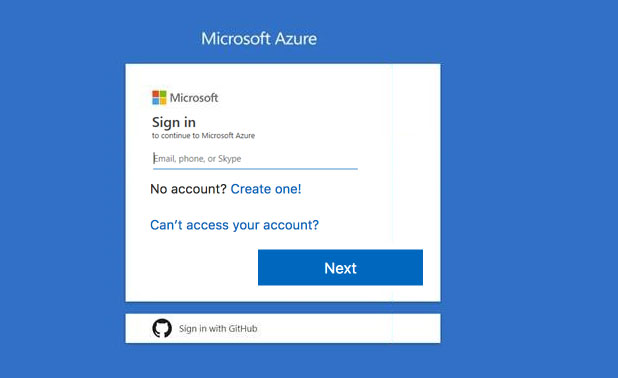
You plan to create several virtual machines in different availability zones, and then to configure the virtual machines for load balanced connections from the Internet. You need to create an IP address resource named ip1006 to support the planned load balancing solution. The solution must minimize costs. What should you do from the Azure portal?
HOTSPOT - You need to implement Role1. Which command should you run before you create Role1? To answer, select the appropriate options in the answer area. NOTE: Each correct selection is worth one point. Hot Area:
HOTSPOT - You have an Azure subscription named Subscription1 that contains a resource group named RG1. In RG1, you create an internal load balancer named LB1 and a public load balancer named LB2. You need to ensure that an administrator named Admin1 can manage LB1 and LB2. The solution must follow the principle of least privilege. Which role should you assign to Admin1 for each task? To answer, select the appropriate options in the answer area. NOTE: Each correct selection is worth one point. Hot Area:
Access Full AZ-103 Exam Prep Free
Want to go beyond these 50 questions? Click here to unlock a full set of AZ-103 exam prep free questions covering every domain tested on the exam.
We continuously update our content to ensure you have the most current and effective prep materials.
Good luck with your AZ-103 certification journey!


